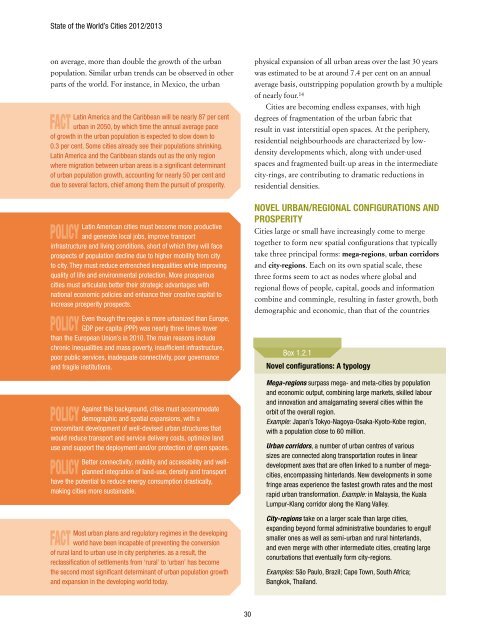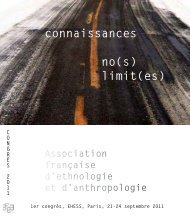state of the world's cities 2012/2013 - United Nations Sustainable ...
state of the world's cities 2012/2013 - United Nations Sustainable ...
state of the world's cities 2012/2013 - United Nations Sustainable ...
You also want an ePaper? Increase the reach of your titles
YUMPU automatically turns print PDFs into web optimized ePapers that Google loves.
State <strong>of</strong> <strong>the</strong> World’s Cities <strong>2012</strong>/<strong>2013</strong>on average, more than double <strong>the</strong> growth <strong>of</strong> <strong>the</strong> urbanpopulation. Similar urban trends can be observed in o<strong>the</strong>rparts <strong>of</strong> <strong>the</strong> world. For instance, in Mexico, <strong>the</strong> urbanFACTLatin America and <strong>the</strong> Caribbean will be nearly 87 per centurban in 2050, by which time <strong>the</strong> annual average pace<strong>of</strong> growth in <strong>the</strong> urban population is expected to slow down to0.3 per cent. Some <strong>cities</strong> already see <strong>the</strong>ir populations shrinking.Latin America and <strong>the</strong> Caribbean stands out as <strong>the</strong> only regionwhere migration between urban areas is a significant determinant<strong>of</strong> urban population growth, accounting for nearly 50 per cent anddue to several factors, chief among <strong>the</strong>m <strong>the</strong> pursuit <strong>of</strong> prosperity.policyLatin American <strong>cities</strong> must become more productiveand generate local jobs, improve transportinfrastructure and living conditions, short <strong>of</strong> which <strong>the</strong>y will faceprospects <strong>of</strong> population decline due to higher mobility from cityto city. They must reduce entrenched inequalities while improvingquality <strong>of</strong> life and environmental protection. More prosperous<strong>cities</strong> must articulate better <strong>the</strong>ir strategic advantages withnational economic policies and enhance <strong>the</strong>ir creative capital toincrease prosperity prospects.policyEven though <strong>the</strong> region is more urbanized than Europe,GDP per capita (PPP) was nearly three times lowerthan <strong>the</strong> European Union’s in 2010. The main reasons includechronic inequalities and mass poverty, insufficient infrastructure,poor public services, inadequate connectivity, poor governanceand fragile institutions.policyAgainst this background, <strong>cities</strong> must accommodatedemographic and spatial expansions, with aconcomitant development <strong>of</strong> well-devised urban structures thatwould reduce transport and service delivery costs, optimize landuse and support <strong>the</strong> deployment and/or protection <strong>of</strong> open spaces.policyBetter connectivity, mobility and accessibility and wellplannedintegration <strong>of</strong> land-use, density and transporthave <strong>the</strong> potential to reduce energy consumption drastically,making <strong>cities</strong> more sustainable.FACTMost urban plans and regulatory regimes in <strong>the</strong> developingworld have been incapable <strong>of</strong> preventing <strong>the</strong> conversion<strong>of</strong> rural land to urban use in city peripheries. as a result, <strong>the</strong>reclassification <strong>of</strong> settlements from ‘rural’ to ‘urban’ has become<strong>the</strong> second most significant determinant <strong>of</strong> urban population growthand expansion in <strong>the</strong> developing world today.physical expansion <strong>of</strong> all urban areas over <strong>the</strong> last 30 yearswas estimated to be at around 7.4 per cent on an annualaverage basis, outstripping population growth by a multiple<strong>of</strong> nearly four. 14Cities are becoming endless expanses, with highdegrees <strong>of</strong> fragmentation <strong>of</strong> <strong>the</strong> urban fabric thatresult in vast interstitial open spaces. At <strong>the</strong> periphery,residential neighbourhoods are characterized by lowdensitydevelopments which, along with under-usedspaces and fragmented built-up areas in <strong>the</strong> intermediatecity-rings, are contributing to dramatic reductions inresidential densities.Novel Urban/Regional Configurations andProsperityCities large or small have increasingly come to mergetoge<strong>the</strong>r to form new spatial configurations that typicallytake three principal forms: mega-regions, urban corridorsand city-regions. Each on its own spatial scale, <strong>the</strong>sethree forms seem to act as nodes where global andregional flows <strong>of</strong> people, capital, goods and informationcombine and commingle, resulting in faster growth, bothdemographic and economic, than that <strong>of</strong> <strong>the</strong> countriesBox 1.2.1Novel configurations: A typologyMega-regions surpass mega- and meta-<strong>cities</strong> by populationand economic output, combining large markets, skilled labourand innovation and amalgamating several <strong>cities</strong> within <strong>the</strong>orbit <strong>of</strong> <strong>the</strong> overall region.Example: Japan’s Tokyo-Nagoya-Osaka-Kyoto-Kobe region,with a population close to 60 million.Urban corridors, a number <strong>of</strong> urban centres <strong>of</strong> varioussizes are connected along transportation routes in lineardevelopment axes that are <strong>of</strong>ten linked to a number <strong>of</strong> mega<strong>cities</strong>,encompassing hinterlands. New developments in somefringe areas experience <strong>the</strong> fastest growth rates and <strong>the</strong> mostrapid urban transformation. Example: in Malaysia, <strong>the</strong> KualaLumpur-Klang corridor along <strong>the</strong> Klang Valley.City-regions take on a larger scale than large <strong>cities</strong>,expanding beyond formal administrative boundaries to engulfsmaller ones as well as semi-urban and rural hinterlands,and even merge with o<strong>the</strong>r intermediate <strong>cities</strong>, creating largeconurbations that eventually form city-regions.Examples: São Paulo, Brazil; Cape Town, South Africa;Bangkok, Thailand.30





